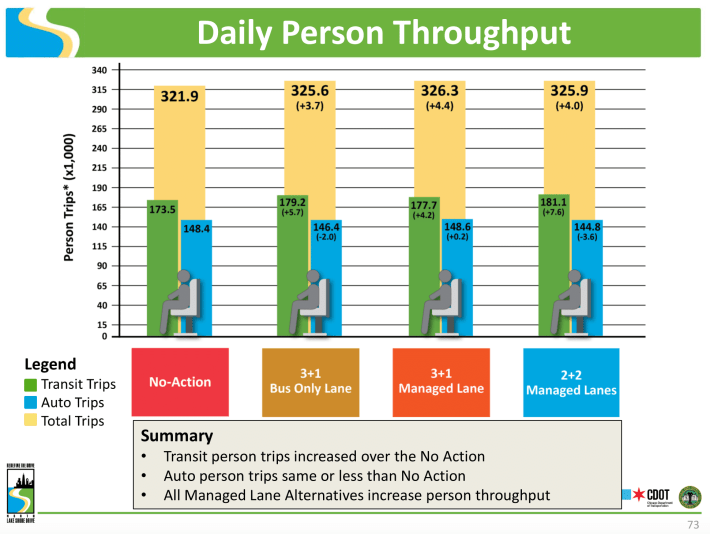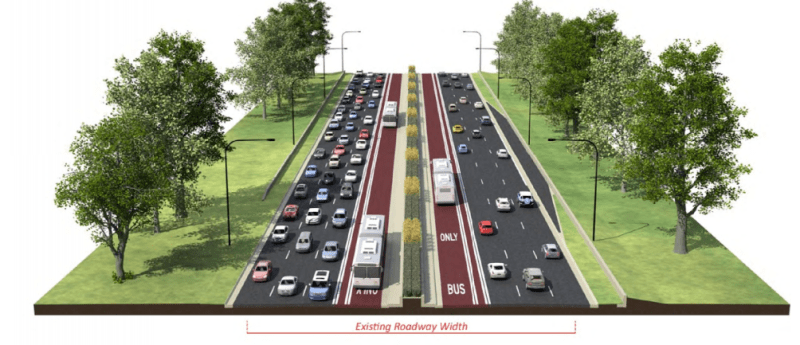Back in June, the Illinois Department of Transportation and other local decision-makers made an incredibly backwards-thinking decision to essentially eliminate the possibility of bus-only lanes being included in the North Lake Shore Drive redesign, and Streetsblog Chicago pointed out that was completely unacceptable. The good news is that, thanks to the pushback from Streetsblog, other advocacy organizations, the CTA, and outraged citizens, that misguided decision has been reversed.
Technically in June the officials preserved the option of including bus lanes, but only if the drive was expanded to accommodate them, rather than converting existing mixed-traffic lanes. But that would have required widening the highway into a ten-lane behemoth, possibly gobbling up parkland, a scenario that no one actually wanted.
The only other remaining scenario under consideration that would have excluded the general motoring public from lanes for buses was a "managed lane" scheme. These lanes that would be shared by buses and drivers who pay a congestion-priced toll. But that wouldn't have given transit riders the same timesaving advantage as real bus lanes, and the congestion pricing could be tricky to implement, with the risk of a political backlash if steep fees are needed to keep traffic flowing.
At the time, IDOT spokesperson Maria Castaneda said the decision to, in effect, remove bus lanes from consideration "was a collective one based on data and feedback that’s been accumulated during the course of the study. There is no voting or one person or agency that made this call."
Castaneda added that the North Lake Shore Drive project is following the National Environmental Policy Act regulations, which require consideration of stakeholder input as well as "a rigorous and objective technical evaluation."
She stated that the scenario with bus-only lanes with no expansion of the drive, known as The 3+1 Bus Only option (3+1 BOL), "improves transit mobility but worsens mobility for other modes and diverts the most traffic to the arterial system. This causes a ripple effect, as congestion in the general purpose lanes affects mobility at the junctions, the inner drive and the neighborhoods to the west. This impacts bus mobility, since every express bus route utilizes the arterial system and pass through junctions to access the outer drive."
Castaneda argued that the managed lane scenario, in which buses share lanes with tolled drivers "provides nearly identical bus transit performance and reliability as the [bus-only lane] alternative without negatively impacting other transportation modes while minimizing traffic diversion to the arterial system. The 3+1 ML Alternative is projected to improve peak period bus travel times by up to 42 percent and reliability by up to 74 percent."

In theory perhaps, but in practice congestion-priced highway lanes have a checkered history. For example, there could be political backlash if steep fees are needed to keep traffic flowing, such the $40 tolls experienced on a highway in the Washington D.C. area after demand-based pricing was introduced.
Meanwhile, bus-only highway lanes have proven successful in cities around the world. It's also possible that local officials are underestimating how many car trips might be eliminated by making transit faster, more reliable, and therefore appealing. There's also the phenomenon of "traffic evaporation" -- when the amount of capacity for driving is reduced, the demand tends to decrease as well as people opt out of making unnecessary car trips.
Thankfully last week the North Lake Shore Drive project officials reversed course, saying that they'll advance the bus lane option to the next stage of the finals. In addition to Streetsblog's scathing post about the bad decision, much of the credit goes to the Active Transportation Alliance, which organized over 700 residents to sign letters to Mayor Lori Lightfoot, Governor, J.B. Pritzker, and the planners asking them to flip the script.
ATA noted in a blog post that a new online public meeting on the project will be held in September, and it's going to be key for transit supporters to participate and advocate for bus lanes. That really does seem to be the will of the people on this issue, since a 2017 IDOT survey found that respondents' top priority was improving walking, biking, and transit along the drive. Over half of the survey participants said that poor transit speed and reliability on LSD forced them to drive instead of taking the bus.
The following year ATA was joined by a coalition of civic and business groups asking for dedicated bus lanes on Lake Shore Drive, and most of the lakefront aldermen also lent their support the following year.
Planning in our region is often characterized by inertia. The safest move for local officials is to more-or-less stick bow to the car-centric status quo under the assumption that people are going to to keep driving as much in the future as they do now, rather than making bold changes to encourage transit use instead. But if we're going to address the climate crisis and promote a more equitable transportation system, we need to pressure them to think differently.
Join ATA's advocacy supporter list for updates on the North Lake Shore Drive project and to learn how to get involved in advocating for bus lanes this fall.
Follow John Greenfield on Twitter at @greenfieldjohn.




